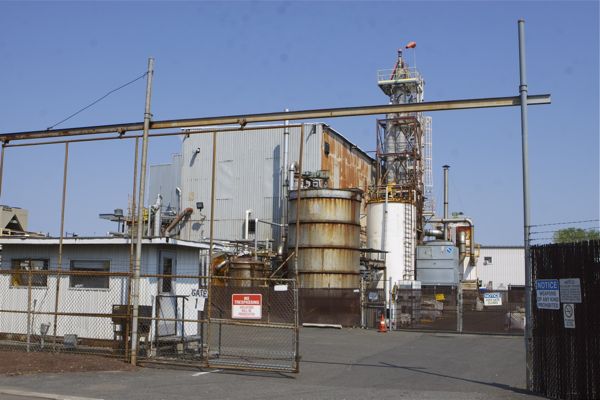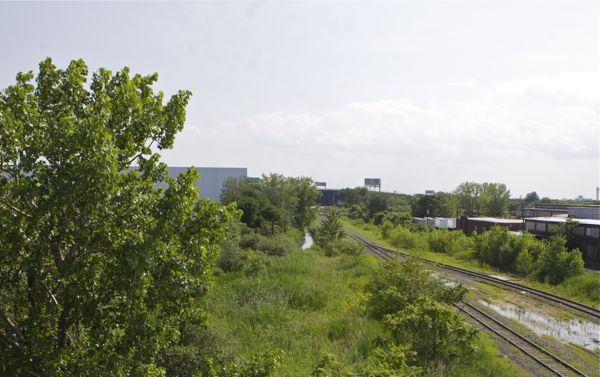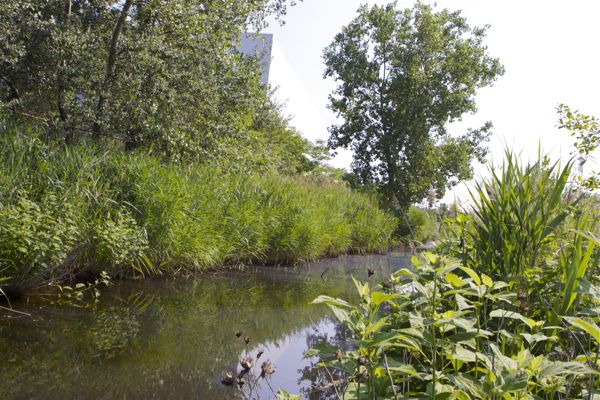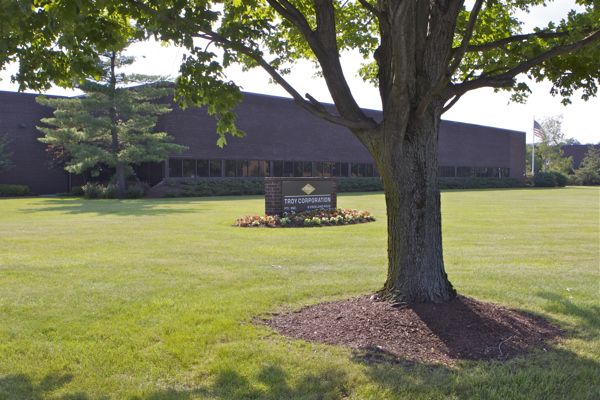Powerful Urban Democrats Join Suburban Republicans to Carry Troy Chemicals’ Water
Troy Chemical Created a Site with some of the Highest Mercury Levels in the World
Part of Larger Corporate Effort to Frustrate Superfund Listing
Notorious Wolff & Samson Law Firm Involved Behind The Scenes
Port Authority “Portfields” Development Initiative Impacted
Even The Teamsters Are Used To Attack EPA
[Update: 9/17/14 – EPA resisted the political pressure and did the right thing.
Star Ledger reports: Contaminated Pierson’s Creek in Newark declared federal Superfund site
But why did Booker get the quote? He did nothing for this site as Newark Mayor. And of course, no NJ media reported on the behind the scenes political lobbying I disclose below. – end update]
Why is south jersey Democrat Lou Greenwald (D-Norcross) trying to block US EPA from listing a highly contaminated site in Newark on the Superfund National Priorities List (NPL)? (Newark is 80 miles from his legislative district).
Why is Newark’s own Democratic Senator Ron Rice also seeking to block the EPA NPL listing of a site in his district that is poisoning his constituents, living in a predominately poor, black and minority environmental justice community? (Ditto for Essex County Freeholders).
Why are Morris County Republican Senators Bucco and Penacchio, US Congressman Frelinghuysen, and the Morris County Freeholders also trying to back EPA off the Newark site, which is not even in their District?
Because they all are shilling for Troy Chemical Company in reckless disregard for the health of their constituents.
Check out this dirty NJ story – and wonder why NJ is the toxic pollution, over-development, and corruption capital of the world.
- Troy Chemical Has a Very Dirty Past – and Present
For many years, numerous studies by independent academic scientists, US EPA, and NJ DEP have shown that the NY Harbor/Newark Bay is highly polluted, particularly the sediments, which are loaded with a witches brew of toxic chemicals, a legacy from the region’s industrial past – the effects of which unfortunately continue into the present.
One of the most toxic of those witches brew of chemicals is mercury, and one of the major sources of the mercury to the entire Newark Bay is a chemical plant in Newark known as Troy Chemical Corporation.
[also look at long known occupational exposure risks at Troy Chemical]
Here’s the history on mercury and the Troy Chemical Co, from a NY Academy of Sciences study (scroll down to Mercury Study):
One of the largest industrial uses of mercury from the turn of the century through most of the 1980s was battery manufacture. One major battery manufacturer was located at Silverlake, NJ. Mercuric nitrate was widely used in the manufacture of felt hats. Many hat manufacturers were located in or near Newark, NJ and New York City. Mercuric fungicides were produced by several small firms in northern New Jersey. Many additional mercury-using and -recycling firms were also sited around the Harbor, including the Troy Chemical Corp., Newark, NJ (originally [1892-1931] owned by Heller and Merz Company). […]
The Troy Chemical Corporation property, Newark, New Jersey, is an active industrial chemical facility. Operations began prior to 1892. The site is drained by the man-made Pierson’s Creek in the center of the property. The Creek drains to the south and discharges into Newark Bay. Pierson’s Creek was originally part of a private drainage system, constructed in the mid-1800s. From 1892 to 1931 the Heller and Merz Company manufactured dyes. Troy Chemical Corporation owned and operated on the property from 1953 to the present. All of Troy’s process wastewaters, including mercury, were discharged untreated into Pierson’s Creek until 1965.
Troy had several operations until about 1965 when a closed-pipe mercury treatment system was built. In 1968 mercury containing products were manufactured. Mercury recovery stills were in operation from 1974 to 1980. Fungicides were manufactured beginning in approximately 1976. This facility continues to manufacture numerous chemicals.
In 1977 Troy installed a containment wall to prevent spilled/leaking materials from migrating into Pierson’s Creek. However, numerous inspections revealed cracks and holes that allowed plant wastewater to discharge directly to the Creek. The firm had many violations of Passaic Valley Sewage Commission (PVSC), and NJ Department of Environmental Protection regulations and permit conditions. Even upgradient offsite soils contained mercury concentrations (140-190 ppm Hg) approaching those considered dangerous. (The New Jersey DEP non-residential direct contact cleanup criterion is 270 ppm.) From January to May 1979 the PVSC collected numerous 24-hour composite samples of the Troy liquid waste. Analyses of these samples indicated that the company was discharging about 330 pounds (= 150 kg) of mercury per day to the PVSC sewage system. Concentrations in onsite sediments (>22,000 and >11,000 ppm Hg) indicate continuous discharges and/or spills of insoluble forms of mercury over several decades.
- EPA Finally Acts
So, after:
- decades of scientific study of a place with perhaps the highest toxic mercury levels in the world,
- serious violations of environmental and OSHA laws (see this and this and this and this),
- massive off site releases of mercury,
- ongoing exposure of people to highly toxic mercury, and
- no effective cleanup plan or operations underway,
Finally, in December 2013, the US EPA proposed to list the Troy Chemical site in Newark on the federal Superfund “National Priorities List” (NPL). [see EPA’s Hazard Ranking Scoring (HRS) of Troy].
EPA explained why the site poses enormous health risks to Newark residents, fishermen, and the ecosystem of the entire Newark Bay complex: (EPA press release)
(New York, N.Y.) The U.S. Environmental Protection Agency today proposed to add the Troy Chemical Corp. site in Newark, New Jersey to its Superfund list of the country’s most hazardous waste sites. Past industrial activity at and in the vicinity of the site, including the manufacture of chemicals, has contaminated Pierson’s Creek, which flows into Newark Bay. Sediment in the creek contains elevated levels of mercury and other pollutants. Previous testing by the New Jersey Department of Environmental Protection showed that some sediment in Pierson’s Creek contained as much as 60% mercury by weight. [Note: that’s 600,000 ppm]
Exposure to even small amounts of mercury can damage people’s nervous systems and harm the brain, heart, kidneys, lungs and immune system. Children and pregnant women are especially vulnerable.
“Mercury is an extremely toxic metal, making it imperative that we make the cleanup of the Troy Chemical Corporation site a priority,” said Judith A. Enck, EPA Regional Administrator. “Mercury from Pierson’s creek is a significant source of contamination in Newark Bay and puts the health of people who eat fish from these waters at risk. By adding the site to the Superfund list, the EPA can ensure that a thorough investigation and cleanup takes place at the Troy Chemical site.”
According to EPA, even the Christie Administration DEP supports the NPL listing – by letter of Aug. 9, 2011:
In 2011, the EPA received a letter of support for placing this site on the NPL from the State of New Jersey.
- Wolff & Samson joins the fray – EPA Backpedals
Curiously, a review of the EPA’s Administrative Record shows that EPA quietly extended the public comment period, but individually notified the notorious NJ law firm of Wolff & Samson via a January 14, 2014 letter!
EPA also wrote an individual letter to powerful DC law firm Steptoe & Johnson on Jan. 13, 2014.
[if that link fails, for access to the record enter EPA-HQ-SFUND-2013-0635 at the website regulations.gov]
EPA extended the comment period without the usual formal Federal Register Notice – instead, below the radar, EPA quietly extended the comment period from February 10, 2014 closing to March 27, 2014 – just enough time to allow Greenwald’s letter.
Will Troy Chemical now become another notch on Wolff & Samson’s notoriously corrupt belt?
- Greenwald Weighs In
So why did Assemblyman Greenwald write a March 18, 2014 letter to US EPA Region 2 Administrator Judith Enck, demanding that she back down and not list the Troy Chemical site, a site 80 miles away from his district and in an environmental justice community?
(I wonder how Greenwald would feel if Newark Senator Rice wrote EPA to block protections for his wealthy white constituents in Cherry Hill?)

Troy Chemical worker wears respirator and protective gear to reduce mercury exposure – photo from NIOSH study of Troy plant
Greenwald wrote to EPA on March 18, 2013. His attack was not limited to the EPA proposed Troy Chemical NPL listing, but also praised Troy Chemical, criticized the entire Superfund program as a “time consuming cost prohibitive process“, and mentioned his NJ State legislation. Greenwald wrote [see EPA Administrative Record for full letter]:
Designating Troy’s Newark facility a Superfund site only would serve to hurt its current manufacturing employees, a segment of New Jersey’s workforce that is critically important to the state’s long term economic growth. Having recently been briefed on Troy’s current remedial efforts pertaining to its Newark property, I believe that this remedial effort must be allowed to continue without delay….
As an elected official I feel it is necessary to also mention that Troy is a good corporate neighbor to Newark. …
Additionally, I am the sponsor of legislation at the state level that would require the New Jersey Department of Environmental Protection to prepare a report and conduct a public hearing prior to recommending a site for inclusion on the federal Superfund list
Does that photo or this look like the behavior of a “good corporate neighbor”? What was Greenwald thinking?
- Greenwald Legislation
We testified against and wrote about the Greenwald legislation. Because Greenwald raised that legislation in his EPA letter, so I must digress and mention a few items on that (see:
- Christie DEP Says Decision to Recommend That EPA List A NJ Toxic Site on federal Superfund Is “Not a Public Process”
- STATE PUSH BACK AGAINST FEDERAL SUPERFUND DESIGNATIONS
- NJ Legislators Propose To Change State Role In Superfund Site Listing Process
First, Assembly Environment Committee Chair Grace Spencer, a black woman who represents Newark and who talks the talk on environmental justice, co-sponsored the Greenwald bill, posted the bill for hearing back in March, and voted in favor of the bill.
But despite my direct questions to her in testimony about what the objective of the bill was and what its impacts would be on NJ communities, Spencer never once mentioned the Troy Chemical site in her District.
Second, more recently, in June the bill was posted and heard in the Senate Environment Committee. After allowing DEP to testify, Chairman Smith tabled the bill before allowing anyone but DEP to testify. Smith asked DEP point blank about the purpose of the bill – specifically why Greenwald sponsored it. DEP verily clearly responded that the bill was a result of a prior controversy about a Superfund site in Greenwald’s district.
Now I know why Smith didn’t want any testimony on the Greenwald bill. This is quite a horror story.
Are we now to believe that neither Chairman Smith nor DEP knew about the Troy Chemical NPL listing controversy?
- Full Court Press – Greenwald Not Alone – Attack Is Not Limited To The Troy Chemical Site
Greenwald’s attack comments were joined by a host of powerful NJ political players.
They include Newark Senator Rice, Morris County Republican Senator Bucco, Essex County Freeholders, Morris County Chamber of Commerce, the NJ Chemistry Council, the NJ Business and Industry Association, Commerce and Industry Association, the NJ law firm representing Troy, Steptoe & Johnson (DC law firm also representing Troy), and the law firm for property owner “429 Delancy Associates” – [see EPA Administrative Record for these comment letters]
Not surprisingly, the NJ Chemistry Council and NJBIA stressed NJ’s failed and privatized voluntary cleanup program and DEP oversight as the better alternative than federal Superfund. Corporate polluters love that toothless DEP and privatized scam.
The Port Authority is involved, as is Wolff & Samson – my guess is that is the political power behind this campaign.
BTW, a gentleman by the name of Rocco Ruggiero warned EPA that he planned to purchase the site – I wonder what’s up with Rocco and his friends and financiers. Sounds like an interesting backstory.
And the only environmental comment came from NY/NJ Baykeeper. And those comments were right on point (but focused heavily on DEP Clean Water Act Section 303(d) water quality impairments and mercury fish and shellfish consumption advisories, but should have included the historical scientific work I link to above).
- What’s Next? – Gut Checks All Around
So, with all these power politics going on behind the scenes, will EPA fold?
Will the NJ press write this amazing story of corrupt politics?
Will environmental lobbyists and environmental justice advocates hold the urban democrats accountable for betraying their constituents and corporate shilling?
Where’s the new People’s Mayor, Ras Baraka on this issue?
The whole world is watching!
We’ll keep you posted.
[End Note Policy Questions:
Why is the powerful law firm Steptoe & Johnson (DC Office) involved?
There must be national Superfund program angles – could be related to 1) off site releases into Newark Bay, 2) apportionment of liability for a huge multi-source regional problem (a la Hudson River PCB) 3) the man made ditch (a currently hot Clean Water Act issue), 4) ongoing State level voluntary cleanup site triggering EPA Superfund, and 5) operating facility triggering EPA Superfund. Of course, PEER has raised the “black box” Superfund listing issues at a national level (see this and this).





Pingback: WolfeNotes.com » Are These The Kind Of Jobs Democrats Want for NJ?
Pingback: WolfeNotes.com » This is What a “Sacrifice Zone” Looks Like
Pingback: casio カシオ オシアナス
Pingback: WolfeNotes.com » EPA Announces New Region 2 Deputy Administrator & New Independent Scientific Review
Thanks for this, interesting. It has been listed now. What I find amazing about this is that this company is still a functioning concern in 2014. Why? Because inexplicably in 2014 they still have their own personal mercury ditch, 1960’s style. I predict they won’t last long now.
Pingback: diablo 3 gold
Pingback: wildstar platinum
Pingback: cheap wow gold
Pingback: aion tower of eternity
Pingback: wow guide
Pingback: fitflop sko
Pingback: vjgirl
Pingback: wowgoldreviews
Pingback: wow gold
Pingback: nike roshe run trainers women
Pingback: wow news
Pingback: how to get gil in ffxiv
Pingback: Roger Vivier flats
Pingback: wow guides
Pingback: final fantasy mmo
Pingback: wildstar item
Pingback: Guild Wars 2 Gold
Pingback: diablo 3 gold
Pingback: FFXIV Gil
Pingback: fitflop salg
Pingback: sb
Pingback: tongs fitflop
Pingback: lunettes oakley jawbone
Pingback: sb google
Pingback: ray ban 3321 e masculino ou feminino
Pingback: sb google
Pingback: mac cosmetics outlet
Pingback: nike air max 24 7 mens
Pingback: nike shoes online uk
Pingback: nike roshe run mid top
Pingback: nike sunglasses uk
Pingback: uk nike roshe
Pingback: nike roshe run light blue
Pingback: acheter nike air max 90
Pingback: nike air force one uk
Pingback: WolfeNotes.com » NJ Senate to Hear Bill That Would Politicize Superfund Listing Decisions
Pingback: WolfeNotes.com » NJ DEP Commissioner Misleads The Public About The DEP Role In Hackensack River Superfund Designation